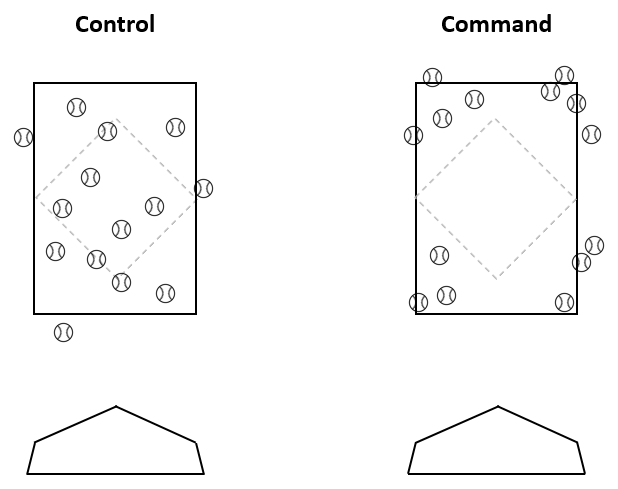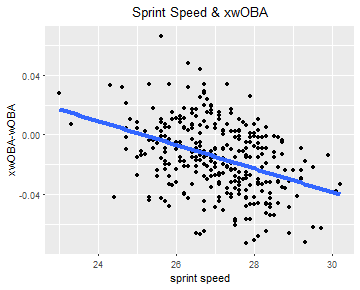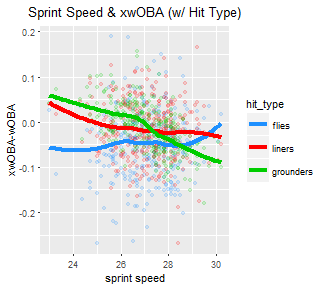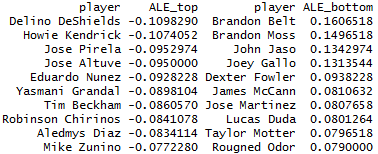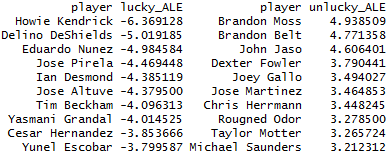As I stated in my earlier article, I would be posting data from my pitch-effectiveness measurement I introduced. Let’s start with the starting pitchers.
1. Top Ten Four-Seam Fastballs (Min 500):
| Player |
Sw+Whf% |
Sw+Whf% Z |
xwOBA |
xwOBA Z |
Z Total |
| Chris Sale |
85.89 |
3.08 |
0.24 |
2.86 |
5.94 |
| Jacob deGrom |
83.06 |
2.68 |
0.27 |
2.13 |
4.81 |
| Jose Berrios |
74.74 |
1.51 |
0.27 |
1.97 |
3.48 |
| Jimmy Nelson |
76.65 |
1.78 |
0.30 |
1.34 |
3.12 |
| Jeff Samardzija |
75.97 |
1.68 |
0.30 |
1.34 |
3.02 |
| Max Scherzer |
73.97 |
1.40 |
0.29 |
1.55 |
2.95 |
| Chase Anderson |
74.24 |
1.44 |
0.29 |
1.45 |
2.89 |
| Rick Porcello |
77.50 |
1.90 |
0.31 |
0.87 |
2.77 |
| James Paxton |
73.32 |
1.31 |
0.29 |
1.42 |
2.73 |
| Danny Salazar |
80.27 |
2.29 |
0.33 |
0.42 |
2.71 |
The Stars: Chris Sale, Jacob deGrom, Max Scherzer, James Paxton
Young and Coming: Jose Berrios
Surprises: Rick Porcello, Chase Anderson, Jeff Samardzija
This group includes some bona-fide talent and some surprises. Porcello’s 1.90 Z-Score on the Sw+Whf% jumps out, considering his lack of stuff and general pitch to contact. Anderson is quietly putting together a solid season, with a 2.88 ERA in 122 innings of work. Samardzija’s incredible strikeout and walk peripherals have been well documented this year.
2. Top Ten Two-Seam Fastballs (Min 300):
| Player |
Sw+Whf% |
Sw+Whf% Z |
xwOBA |
xwOBA Z |
Z Total |
| Sonny Gray |
72.12 |
2.18 |
0.30 |
1.39 |
3.57 |
| Jaime Garcia |
67.96 |
1.49 |
0.28 |
1.97 |
3.46 |
| David Price |
72.83 |
2.29 |
0.32 |
0.86 |
3.15 |
| Lance Lynn |
66.66 |
1.27 |
0.31 |
1.16 |
2.43 |
| Matt Garza |
65.31 |
1.05 |
0.30 |
1.34 |
2.39 |
| Luis Castillo |
64.66 |
0.94 |
0.30 |
1.44 |
2.38 |
| Chris Sale |
65.23 |
1.04 |
0.30 |
1.34 |
2.38 |
| Jameson Taillon |
69.98 |
1.82 |
0.34 |
0.40 |
2.23 |
| J.A. Happ |
63.82 |
0.80 |
0.30 |
1.29 |
2.09 |
| Julio Teheran |
69.27 |
1.71 |
0.35 |
0.20 |
1.91 |
The Stars: Sonny Gray, David Price, Chris Sale, Julio Teheran
Young and Coming: Jameson Taillon, Luis Castillo
Surprises: Jaime Garcia, Matt Garza
We see Sale again, which, considering what he has done this year, is not surprising. Garza has been generally terrible this year, so his inclusion in this list is unexpected. Castillo, a rookie for the Cincinnati Reds, has pieced together some quality starts out of the spotlight.
3. Top Five Cut Fastballs (Min 200):
| Player |
Sw+Whf% |
Sw+Whf% Z |
xwOBA |
xwOBA Z |
Z Total |
| James Paxton |
89.03 |
1.81 |
0.20 |
2.03 |
3.84 |
| Corey Kluber |
97.90 |
2.82 |
0.28 |
0.48 |
3.30 |
| Tyler Chatwood |
84.08 |
1.25 |
0.21 |
1.81 |
3.06 |
| John Lackey |
84.72 |
1.32 |
0.26 |
0.85 |
2.17 |
| Zack Godley |
78.94 |
0.66 |
0.24 |
1.39 |
2.05 |
(Only five because the small use of cutters)
The Stars: James Paxton, Corey Kluber
Young and Coming: Zach Godley
Surprises: Tyler Chatwood
We see Paxton again, who has established himself as a star this season. Godley has been great for the Arizona Diamondbacks, and Tyler Chatwood has been poor for the Colorado Rockies.
4. Top Five Sinker Fastball (Min 200):
| Player |
Sw+Whf% |
Sw+Whf% Z |
xwOBA |
xwOBA Z |
Z Total |
| Trevor Williams |
68.72 |
1.87 |
0.30 |
1.73 |
3.61 |
| Jimmy Nelson |
65.69 |
1.43 |
0.32 |
1.11 |
2.54 |
| Jose Quintana |
64.77 |
1.29 |
0.32 |
1.18 |
2.47 |
| Jon Lester |
61.89 |
0.87 |
0.31 |
1.29 |
2.17 |
| Jake Arrieta |
58.31 |
0.35 |
0.31 |
1.43 |
1.78 |
(Only five because the small use of sinkers)
The Stars: Jake Arrieta, Jon Lester, Jose Quintana
Young and Coming: Trevor Williams
Surprises: None
An emerging starter for the Pittsburgh Pirates, an emerging ace for the Milwaukee Brewers, and…three Chicago Cubs. I gave the Cubs pitchers the benefit of the doubt and put them under “The Stars” category, but they may have pitched their way out of there this season.
5. Top Two Splitter Fastball (Min 200):
| Player |
Sw+Whf% |
Sw+Whf% Z |
xwOBA |
xwOBA Z |
Z Total |
| Kevin Gausman |
94.79 |
0.96 |
0.21 |
1.61 |
2.57 |
| Ricky Nolasco |
95.42 |
1.02 |
0.22 |
1.35 |
2.37 |
The splitter leaderboard included only nine starters, so this one is short. Kevin Gausman has rebounded from a horrendous start to be solid, and Ricky Nolasco has continued to provide what he always has: mediocrity.
6. Top Ten Curveball (Min 300):
| Player |
Sw+Whf% |
Sw+Whf% Z |
xwOBA |
xwOBA Z |
Z Total |
| Corey Kluber |
109.61 |
3.16 |
0.12 |
2.26 |
5.42 |
| Charlie Morton |
88.69 |
1.30 |
0.17 |
1.44 |
2.74 |
| James Paxton |
84.54 |
0.93 |
0.16 |
1.49 |
2.42 |
| Zack Godley |
93.67 |
1.74 |
0.22 |
0.60 |
2.35 |
| Aaron Nola |
87.91 |
1.23 |
0.19 |
1.07 |
2.30 |
| Carlos Carrasco |
88.65 |
1.30 |
0.19 |
0.99 |
2.28 |
| Ivan Nova |
84.32 |
0.91 |
0.18 |
1.21 |
2.12 |
| James Shields |
91.18 |
1.52 |
0.22 |
0.50 |
2.02 |
| Alex Meyer |
82.68 |
0.76 |
0.19 |
1.07 |
1.84 |
| Jon Lester |
89.57 |
1.38 |
0.22 |
0.45 |
1.82 |
The Stars: Corey Kluber, James Paxton, Carlos Carrasco
Young and Coming: Zach Godley
Surprises: James Shields, Alex Meyer, John Lester, Charlie Morton
We see Kluber again, and Godley again, and Paxton for a third time. No surprise considering the seasons they have put up. Shields’ days as a front-of-the-rotation starter are far behind him. Meyer has quietly put together some solid starts for the Los Angeles Angels as a complete unknown. Lester is a surprise here because this is his second leaderboard appearance, and he has not pitched well. Morton is mostly known for his injury problems, but he has developed some of the best “stuff” in the game in his first year in Houston.
7. Top Ten Slider (Min 300):
| Player |
Sw+Whf% |
Sw+Whf% Z |
xwOBA |
xwOBA Z |
Z Total |
| Carlos Carrasco |
108.62 |
2.51 |
0.15 |
2.06 |
4.56 |
| Max Scherzer |
104.66 |
2.10 |
0.17 |
1.79 |
3.89 |
| Sonny Gray |
97.27 |
1.35 |
0.16 |
1.87 |
3.22 |
| Dylan Bundy |
99.46 |
1.58 |
0.19 |
1.28 |
2.85 |
| Clayton Kershaw |
101.38 |
1.77 |
0.22 |
0.82 |
2.59 |
| Patrick Corbin |
94.91 |
1.11 |
0.19 |
1.24 |
2.35 |
| Marcus Stroman |
96.92 |
1.32 |
0.21 |
1.03 |
2.34 |
| Zack Greinke |
104.05 |
2.04 |
0.24 |
0.30 |
2.34 |
| Mike Clevinger |
96.96 |
1.32 |
0.21 |
1.01 |
2.33 |
| Mike Leake |
96.40 |
1.27 |
0.21 |
0.93 |
2.20 |
The Stars: Carlos Carrasco, Max Scherzer, Sonny Gray, Clayton Kershaw, Marcus Stroman, Zach Greinke
Young and Coming: Dylan Bundy, Mike Clevinger
Surprises: Patrick Corbin
Finally! The man we have been waiting to see, Kershaw, makes his first appearance. As does Scherzer. The star power of this group is by far the strongest. Bundy has been “Young and Coming” for decades it seems now, and no one knows if the flashes will become consistency ever. Still just 24 years old, though, so I will keep my hopes up. Clevinger has been a nice surprise for the Cleveland Indians, and Corbin has bounced back from a miserable 2016 to be solid for the Arizona Diamondbacks.
8. Top Ten Changeup (Min 300):
| Player |
Sw+Whf% |
Sw+Whf% Z |
xwOBA |
xwOBA Z |
Z Total |
| Stephen Strasburg |
104.30 |
2.31 |
0.15 |
2.76 |
5.07 |
| Luis Castillo |
97.25 |
1.46 |
0.18 |
2.27 |
3.73 |
| Danny Salazar |
102.60 |
2.11 |
0.23 |
1.01 |
3.12 |
| Kyle Hendricks |
95.35 |
1.23 |
0.22 |
1.25 |
2.49 |
| Max Scherzer |
90.38 |
0.63 |
0.20 |
1.72 |
2.35 |
| Edinson Volquez |
91.28 |
0.74 |
0.21 |
1.54 |
2.28 |
| Carlos Carrasco |
86.47 |
0.16 |
0.19 |
1.90 |
2.06 |
| Eduardo Rodriguez |
95.70 |
1.28 |
0.26 |
0.48 |
1.76 |
| Jason Vargas |
91.99 |
0.83 |
0.26 |
0.46 |
1.29 |
| Cole Hamels |
93.09 |
0.96 |
0.27 |
0.24 |
1.20 |
The Stars: Stephen Strasburg, Kyle Hendricks, Max Scherzer, Carlos Carrasco, Cole Hamels
Young and Coming: Luis Castillo, Eduardo Rodriguez
Surprises: Edinson Volquez
Scherzer again, which makes me feel better about the validity of this work. Carrasco for the third time in a row. His breaking and offspeed stuff are killer. Very few people outside of Cincinnati know Castillo, but this is the rookie’s second leaderboard appearance. Rodriguez has continued to flash this year, but injuries and inconsistency continue for the young Red Sock. Volquez is still embracing his mediocrity.
Starters Top Fifteen Overall:
| Pitch |
Player |
Sw+Whf% |
Sw+Whf% Z |
xwOBA |
xwOBA Z |
Z Total |
| 4-Seam |
Chris Sale |
85.89 |
3.08 |
0.24 |
2.86 |
5.94 |
| Curveball |
Corey Kluber |
109.61 |
3.16 |
0.12 |
2.26 |
5.42 |
| Changeup |
Stephen Strasburg |
104.30 |
2.31 |
0.15 |
2.76 |
5.07 |
| 4-Seam |
Jacob deGrom |
83.06 |
2.68 |
0.27 |
2.13 |
4.81 |
| Slider |
Carlos Carrasco |
108.62 |
2.51 |
0.15 |
2.06 |
4.56 |
| Slider |
Max Scherzer |
104.66 |
2.10 |
0.17 |
1.79 |
3.89 |
| Cutter |
James Paxton |
89.03 |
1.81 |
0.20 |
2.03 |
3.84 |
| Changeup |
Luis Castillo |
97.25 |
1.46 |
0.18 |
2.27 |
3.73 |
| Sinker |
Trevor Williams |
68.72 |
1.87 |
0.30 |
1.73 |
3.61 |
| 2-Seam |
Sonny Gray |
72.12 |
2.18 |
0.30 |
1.39 |
3.57 |
| 4-Seam |
Jose Berrios |
74.74 |
1.51 |
0.27 |
1.97 |
3.48 |
| 2-Seam |
Jaime Garcia |
67.96 |
1.49 |
0.28 |
1.97 |
3.46 |
| Cutter |
Corey Kluber |
97.90 |
2.82 |
0.28 |
0.48 |
3.30 |
| Slider |
Sonny Gray |
97.27 |
1.35 |
0.16 |
1.87 |
3.22 |
| 2-Seam |
David Price |
72.83 |
2.29 |
0.32 |
0.86 |
3.15 |
Best Pitch: Chris Sale, Boston Red Sox, 4-Seam Fastball
Best Repertoire: Corey Kluber, Cleveland Indians
Biggest Surprise: Luis Castillo, Cincinnati Reds, Changeup
This list is almost all household names. In first and second, we have the AL Cy Young frontrunners. Jeff Sullivan recently wrote an article about Kluber’s curveball, and how it may be the best pitch in baseball. It isn’t number one here, but second place is not too shabby. His cutter also appears here, so his dominance is not hard to explain. Sonny Gray’s stuff is well known, and he shows up twice on this table, but his numbers are not spectacular this year. Lastly, watch out for Castillo. He’s a no-name rook, but he has been solid for the Reds, and the ranking of his changeup may be the evidence to support his success.
Next up is relievers.





